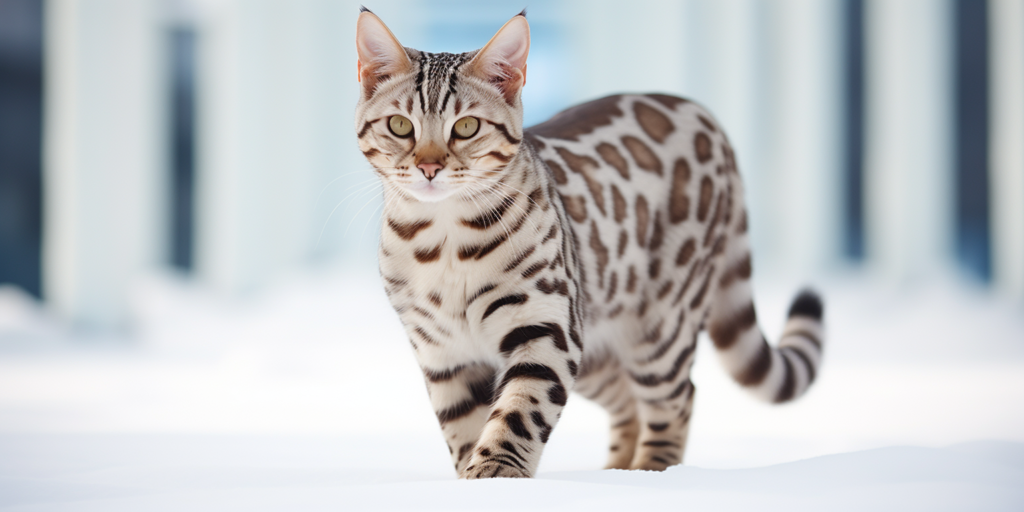Are you enchanted by the stunning appearance of a Bengal cat and considering bringing one into your home, but concerned about allergies? You might be asking yourself: Is the Bengal cat hypoallergenic?
This question is crucial for potential cat owners who love the idea of a feline companion but dread the thought of allergic reactions.
In this comprehensive exploration, we will delve into the hypoallergenic qualities of Bengal cats, providing insights for those with concerns about allergies.

The quest to find a hypoallergenic cat has led many allergy sufferers to explore the Bengal cat as a potential pet.
Cats are notorious for causing allergic reactions in some individuals, with typical symptoms such as sneezing, itching, and watery eyes.
But what if there was a breed that could alleviate these concerns? Enter the Bengal cat, with its exotic looks and rumored hypoallergenic properties.
This captivating breed has sparked interest and hopes for a sneeze-free coexistence between cats and allergic individuals.
Hypoallergenic Bengal Cat – What Does it Mean?
The allure of a hypoallergenic Bengal cat offers hope to many aspiring pet owners who suffer from allergies. Often, this term hypoallergenic is used to describe animals that are less likely to provoke allergic symptoms, but what does it truly mean about Bengals?
By nature, some cats secrete less Fel d 1, the common protein responsible for triggering allergic responses. This is where the interest in Bengals as possible hypoallergenic pets comes into play.
To ascertain if your feline friend falls into this coveted category, consider available tests from online sources or your vet’s office. These tests aim to measure the amount of allergen-inducing proteins your cat produces, offering insight into their potential for causing allergies.
It’s important to note, however, that individual reactions to cats can vary widely and testing is just one component in determining compatibility between you and a Bengal cat.
Is the Bengal Cat Hypoallergenic?
While searching for cats that are friendly for allergy sufferers, people often ask if Bengal cats are hypoallergenic.
Although no cat breed is entirely devoid of allergens, Bengals are typically considered to have a low to medium likelihood of causing allergic reactions.
They produce a standard level of Fel d 1 and exhibit average shedding rates. Fortunately, their naturally short and silky coats contribute to easier grooming practices, helping manage allergens in your living environment.
Bengals may hence be described as a favorable option, though not flawless, for allergy sufferers seeking the joy of cat ownership.
As with any breed, potential owners need to spend time with Bengals before adoption to assess their reactions.
For those with moderate sensitivities to allergens, Bengals could prove to be compatible companions who don’t compromise their owners’ comfort and well-being.

How to Check if You Are Allergic to Bengal Cat
Identifying an allergy to Bengal cats begins with recognizing common signs, which range from mild sniffles to more severe asthmatic reactions.
These symptoms include sneezing, coughing, wheezing, and itchy eyes—classic indicators of an allergic response.
Severity varies greatly among individuals; while some may experience immediate effects upon contact with a cat, others might notice symptoms emerging hours later.
For those concerned about potential allergies to a Bengal cat but unsure of their sensitivity level, spending time around the breed can be both enjoyable and informative.
Interactions can help determine your body’s response and gauge your compatibility with these creatures.
Should you observe any symptoms resurfacing—or if you wish to bypass uncertainty—visiting shelters or breeders where Bengals are present offers a real-world setting for testing your reactions.
Interaction With Bengal Cat
Interacting directly with Bengals can provide invaluable answers for those on the fence about feline allergies.
Spending time at a breeder’s facility or an animal shelter can put you in the presence of multiple cats, including Bengals, increasing the likelihood of experiencing any allergens firsthand.
Keep note of how your body reacts during these encounters—whether it’s immediate discomfort or delayed symptoms—to better understand your tolerance levels.
Imagine engaging with a Bengal—admiring its beautiful coat and distinctive markings—while monitoring how you feel physically. It could be that you experience no adverse reactions, thus signaling compatibility with this breed.
On the contrary, if your allergies flare up, it’ll become evident that owning a Bengal might require additional measures for managing allergens effectively.

Have an Allergy Test
For individuals desiring a scientific approach to determine their compatibility with Bengals, allergy testing looms as a valuable resource. Various labs and veterinary clinics have developed tests targeting specific breeds to provide clarity for potential owners.
Such tests can offer peace of mind or forewarning concerning one’s sensitivity to cat allergens before bringing a Bengal into their home.
An allergy test performed by a qualified professional can confirm whether or not you have a specific sensitivity to Bengals or general cat allergens. The process typically involves exposing the skin or blood to various allergens and observing reactions.
While no test can guarantee absolute accuracy in predicting how you’ll react living day-to-day with a Bengal cat, it can certainly serve as an important tool in your decision-making process.
What Should I Do to Reduce Allergies to Bengal?
Living harmoniously with a Bengal cat while managing allergies is achievable through diligent care and household adjustments. Regularly bathing your cat can aid in removing dander and excess hair that contribute to allergen levels.
Combining daily brushing sessions will further minimize shedding and keep your Bengal’s glamorous coat glistening without spreading allergens.
Frequent hand washing after petting your cat can reduce the spread of allergens to your face or other sensitive areas.
Limiting direct contact with your cat might seem contrary to the affectionate nature of pet ownership, but such measures can significantly alleviate allergy symptoms.
Improving air quality at home through filters and anti-allergen sprays also plays a critical role in maintaining an allergy-friendly environment.
Establishing specific zones within your home where your cat is allowed can limit exposure to allergens. Additionally, maintaining litter box cleanliness will help prevent the buildup and dispersion of irritants.
Wearing gloves during gardening and choosing specific genders or neutering options for your Bengal can impact allergen production as well. If symptoms persist despite these efforts, consulting an allergist for appropriate medications or treatments is advisable.

Conclusion
To conclude our exploration of whether the Bengal cat is hypoallergenic, it’s important to remember that individual reactions vary significantly. While Bengals offer a better alternative for those with mild allergies due to their short coats and grooming habits, no cat is entirely free from allergens. Through interaction and medical testing, potential owners can determine their suitability for adopting these majestic creatures.
For those who are mildly allergic yet still drawn to the allure of a Bengal cat’s charm and personality, implementing strategies for reducing exposure to allergens remains key.
From practical household tips to time spent understanding individual sensitivities toward these felines, managing allergies involves a multifaceted approach.
With careful planning and thoughtful care, owning a Bengal cat could be a viable and fulfilling option even for those navigating the challenges of pet-related allergies.